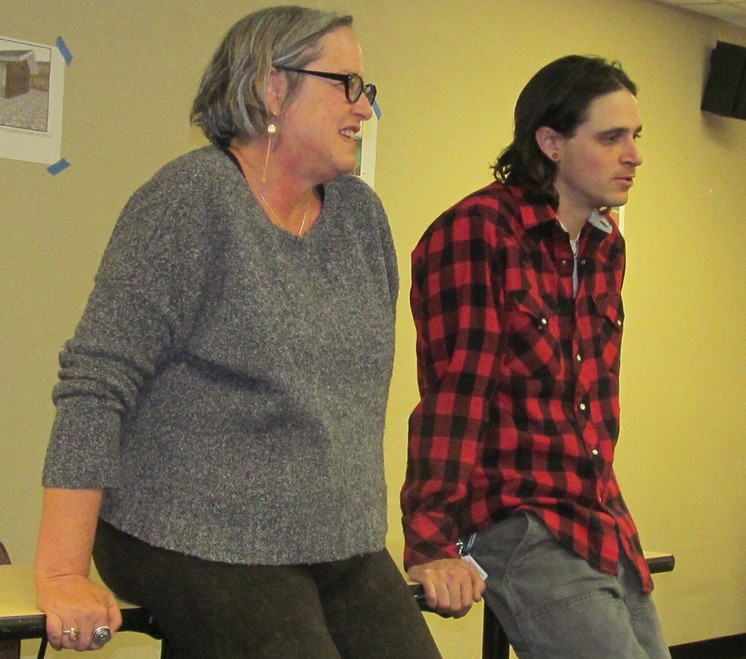RG Farm Park takes input on ed pavilion

ALAMOSA — As buildings take shape at the Rio Grande Farm Park, community members are helping to decide how they will be used.
In two sessions, community members on Wednesday evening provided input on the proposed education pavilion that will be located in the farm park off Highway 17 in Alamosa. The exterior for the 1,800-square-foot building is pretty well determined, but residents shared ideas for how the interior space might be used.
Rio Grande Farm Park Director Julie Mordecai said funding is not yet in place for the pavilion, but the farm park has a grant request in to GOCO (Great Outdoors Colorado) and should know about that funding in March. She said funding is already in place this year for irrigation (sprinkler and drip), fencing, nature playground and maybe a greenhouse, “which is pretty exciting.”
The pavilion, which will be located right next to the nature play area in the master plan for the park, will be available for year-round use. Mordecai said it will not be an open pavilion but will be an enclosed building with heat so it can be used all year.
Also planned on the farm park space are a large event center with seating for about 400 people, a barn, three greenhouses and living space with apartments.
Already available are observation beehives, nursery bat boxes, wetlands, the Rio Grande, working farmland, compost area, orchard, open space, riparian habitat, chickens, acequias and trails.
Mordecai reminded the group that the farm park has been going for about three years and has involved the community in every step of development. “We have gone back to the community to ask ‘What do you think? What do you want’?”
The farm park will involve local contractors as much as possible as well, Mordecai added. In bidding contracts, extra points will be given for local contractors. Sometimes using local resources is not possible. For example, the architect for the nature playground is from Denver and deals exclusively in nature playgrounds, which local architects do not specialize in.
“As much as we can do locally we will do locally,” Mordecai said.
Community members brainstormed ideas for uses, furnishings and decorations for the interior of the education pavilion Wednesday night including the following:
• Make it as flexible as possible for versatile uses with furnishings and partitions that can be moved
• Furnishings could be natural or nature themed, like stools resembling wood stumps, and use recycled materials for chairs, tables and shelving; make microscopes available
• Technology should be available for presentations, a large wall for projection for example
• Technology should enhance the primary experience of working with the land, being outside, and the focus of the inside should be on getting people outside
• Access to water, sink, small kitchen for classes and farm-to-table lessons, bridging the gap between growing plants and eating food
• Farmers said they needed walk-in coolers, refrigerators, freezers, washing sinks to wash their vegetables, packing area and canning area
• Shop tools available for building projects like birdhouses; farming tools and classes on how to use them
• Bird blind in this area
• Maps, local art, murals, posters especially that feature local fauna and flora, movable exhibits on the walls; perhaps a living wall with herbs growing on it; even a bee colony in the wall, visible through a window; hands on interactive displays
• Activities could include education on environment, water, conservation, planting and harvesting; hands-on workshops; solar; bike maintenance; medicinal herbs workshops; ecosystem education; contests teaching youth how to grow, for example a contest at the end of the season for who grew the biggest produce; arts and crafts areas and displays; farming classes; Spanish classes; nutritional counseling and classes for families; homework assistance for youth; activities for families to do together especially in wintertime when they can’t get outside as much
• Other groups could use the space and youth such as FFA members would be encouraged to participate in activities at the pavilion
• Farm tours could be operated out of the pavilion
• An information desk could provide updates on what is happening on the park, what is growing at the time, for example, as well as information on local history and culture
• Perhaps a little store for arts/crafts and produce
• A place where farmers can order seeds, like catalogues, also books and magazines on farming
• Ask the kids what they want to see in the pavilion (Mordecai said children from the Boys & Girls Club have given input on the nature play area, “and we will go back to them”)
• Ask teachers who use labs in their classrooms what is necessary for that type of education in the pavilion
• Go to other places where there might already be similar buildings in existence to get ideas
• Use the space to get young people interested in farming, since the average age of farmers is approaching 65



